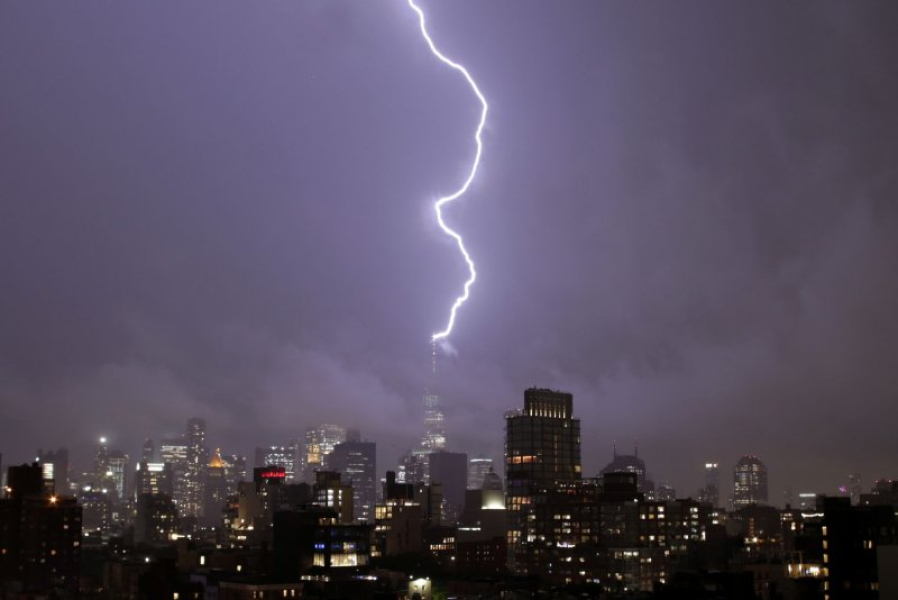
As summer thunderstorm season approaches, the threat of lightning increases, and with it, long-standing myths. From heavy rainfall during storms to filling up your car with gas, lightning myths continue to perpetuate, often putting people at unnecessary risk.
To clarify the situation, AccuWeather spoke with lightning protection expert John Jensenius of the National Lightning Protection Council.
Here's what you need to know:
Myth: It's safe to shower during a thunderstorm.
This is a false and potentially dangerous claim. Both Jensenius and the CDC warn against using any plumbing fixtures during a thunderstorm. “When lightning strikes your home,” Jensenius explained, “it usually travels through wires or plumbing fixtures.” That means taking a shower, washing dishes, or even turning on a faucet can be dangerous. Even non-metal pipes can conduct electricity through water.
Myth: You can't use your phone during a storm.
It’s possible — if it’s wireless. “Mobile phones are safe as long as they’re not plugged into the power grid,” says Jensenius. The danger comes from corded phones or devices that are charging during a thunderstorm. If your phone is charging and you’re holding it when lightning strikes, you’re connected to your home’s power grid, putting you at risk.
Myth: It's safe to fill up your car with gas during a thunderstorm.
Not exactly. Even though most gas station shelters are well grounded, there is still a risk. “There have been cases of explosions,” Jensenius noted. The bigger concern? Lightning strikes nearby can cause a ground current to flow through the area. If you’re outside, you’re at risk even if the shelter doesn’t take a direct hit.
Myth: You should not touch a person who has been struck by lightning.
This is absolutely false. A lightning strike victim does not have an electrical charge. It is safe to touch, and it is important to act quickly. Call 911 and begin first aid or CPR immediately. “The most common cause of death from lightning is cardiac arrest,” the CDC says.
Myth: Lightning won't strike if there's no rain.
That's not true. “If you hear thunder, you're in the strike zone,” Jensenius said. Lightning can strike up to 10 miles away from a thunderstorm — much farther than where it's raining. A lightning strike a few miles away from a thunderstorm is called a “bolt from the blue.” That's why the National Weather Service advises that when thunder sounds, go indoors.
Myth: It is safe to take shelter under a tree.
This is one of the most dangerous misconceptions. Trees are often the tallest objects in the area, making them prime targets for lightning. “When lightning hits a tree, it doesn’t go underground. It travels along the ground and can jump to anyone nearby,” Jensenius explained.
Myth: You're safe outdoors unless you squat.
It’s better than standing still, but still risky. If you find yourself outside, the best thing to do is seek shelter as quickly as possible. “Even if it takes you 15 minutes to get to safety, you’re cutting your risk in half,” Jensenius says. If shelter isn’t available, the CDC recommends squatting in a ball position with your legs together, your head tucked under your head, and your hands over your ears.
Myth: Lightning will not strike the same place twice.
That’s completely untrue. In fact, some places are struck repeatedly. “The Empire State Building is struck by lightning about 23 times a year,” Jensenius said. As one of the tallest buildings in New York Harbor, the Statue of Liberty is also susceptible to lightning strikes. Its height and conductive copper material make it a natural target. The statue is firmly grounded through the concrete and granite base it sits on, according to the National Park Service.
Most lightning deaths are preventable
“Lightning is a threat anywhere in the U.S.,” Jensenius says. “The key is to plan ahead.”
Sourse: www.upi.com





